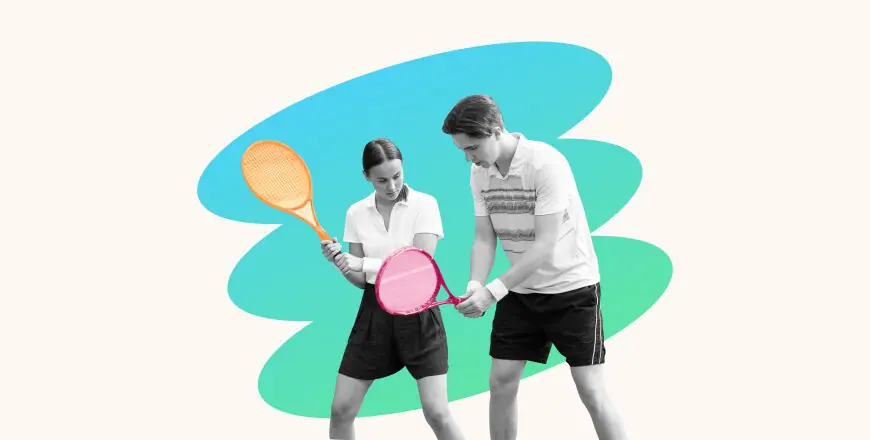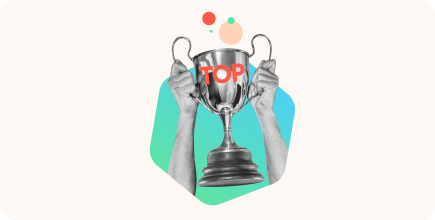LMS Integration: Benefits, Examples, and a Setup Checklist

When choosing an LMS, ease of integration, second only to user experience, is a top priority for L&D professionals. According to ATD Research, 62% say they consider it a lot, and nearly 30% consider it a moderate amount. This is because learning management systems that integrate directly with the tools you already use enhance learning processes and minimize operational complexity.
In this article, we’ll cover everything you need to know about LMS integration: the benefits, the main types, and how to connect an LMS with your tech stack for smoother operations.
What Is LMS Integration?
LMS integration is a learning management system’s ability to share data with other software used in your organization, such as HR systems, CRM, eLearning libraries, or collaboration tools.
Companies need LMS integrations to create seamless learning experiences, automate manual processes, and turn learning data into actionable business insights.
Benefits of Learning Management System Integrations
An integrated LMS does more than just host courses. It becomes the hub for your organization’s learning. With built-in integrations, it connects to the tools your teams already use, like Zoom and your HR system, cutting manual work, reducing errors, and keeping training data accurate.
Let’s take a closer look at the benefits of an integrated LMS.
1. Time savings
By automating data exchange, L&D teams eliminate manual entry and duplicate work. This saves valuable time, allowing them to focus on strategic initiatives that directly boost KPIs.
For example, attendance data and recordings from Zoom training sessions can automatically sync with the LMS instead of being uploaded and tracked manually. Similarly, the LMS can automatically create new employee profiles based on HR system data.
2. Improved data accuracy
Automated data flow reduces the risk of human error. This means fewer mistyped names, misplaced learners, and compliance issues caused by manual updates.
For instance, the automatic synchronization of user roles and departments from HR systems into learning management systems ensures training assignments dynamically adjust to organizational changes.
3. Shorter learning curve
Automated data entry and LMS integrations, such as Single Sign-On (SSO), create a unified learning environment that makes it easier for employees to get started with a new LMS. Some integrations also let you incorporate courses into tools your learners currently use. For example, a sales course in a CRM or live training sessions in Microsoft Teams.
4. Decreased compliance risks
Connecting your LMS to compliance and auditing tools reduces the risk of non-compliance. When learning data flows automatically from the LMS into compliance dashboards, there’s no need for manual data entry or spreadsheet uploads that often lead to typos, missed updates, or mismatched records.
Automated reminders and certification tracking add another layer of protection. The system notifies employees and managers when refresher compliance training or recertifications are due.
Compliance officers receive real-time insights into mandatory training completion, upcoming deadlines, and certifications. This helps them spot potential issues before they become audit problems or penalties.
5. Fostered team collaboration
Syncing your LMS with communication tools like Slack transforms learning from a solitary activity into a collaborative one. Employees can easily discuss course content, share insights, and ask questions in dedicated channels, enriching the learning experience.
For example, automatically posting a notification when a new course is available or creating a team channel for a specific training program encourages knowledge sharing and peer support.
6. Data-driven decision-making
The more systems your LMS connects with, the richer your training insights become. These insights fuel a personalized learning experience, helping you tailor training programs to each employee’s performance and preferences. They also let you measure effectiveness beyond completion rates, identifying what worked, what didn’t, and the exact ROI of every program.
And all this data, in turn, helps you demonstrate the strategic impact of learning programs and justify training budgets.
Also read:
Types and Examples of LMS Integrations
Now, let’s take a quick look at the built-in LMS integrations you should search for in order to get the most out of your learning management system. We’ll cover how each one works and share real-life examples from iSpring LMS, the leading LMS for corporate training. This will help you identify which integrations your organization needs.
1. Human Resource Information System (HRIS)
An LMS-HRIS integration ensures that employee training and HR records remain aligned.
With iSpring LMS, you can easily integrate with BambooHR and OrangeHRM. For instance, when a new hire is added to the HRIS, their details are automatically sent to iSpring LMS, triggering immediate enrollment in required courses (e.g., job-specific, onboarding, or compliance training).
As employees change roles or receive promotions, iSpring LMS updates their training assignments based on their new responsibilities, keeping them up to date with required skills and certifications. If an employee leaves the company, their LMS account is deactivated automatically, eliminating the need for manual updates.
With the integration, you can also track a learning program’s status and check user certificates directly in BambooHR.
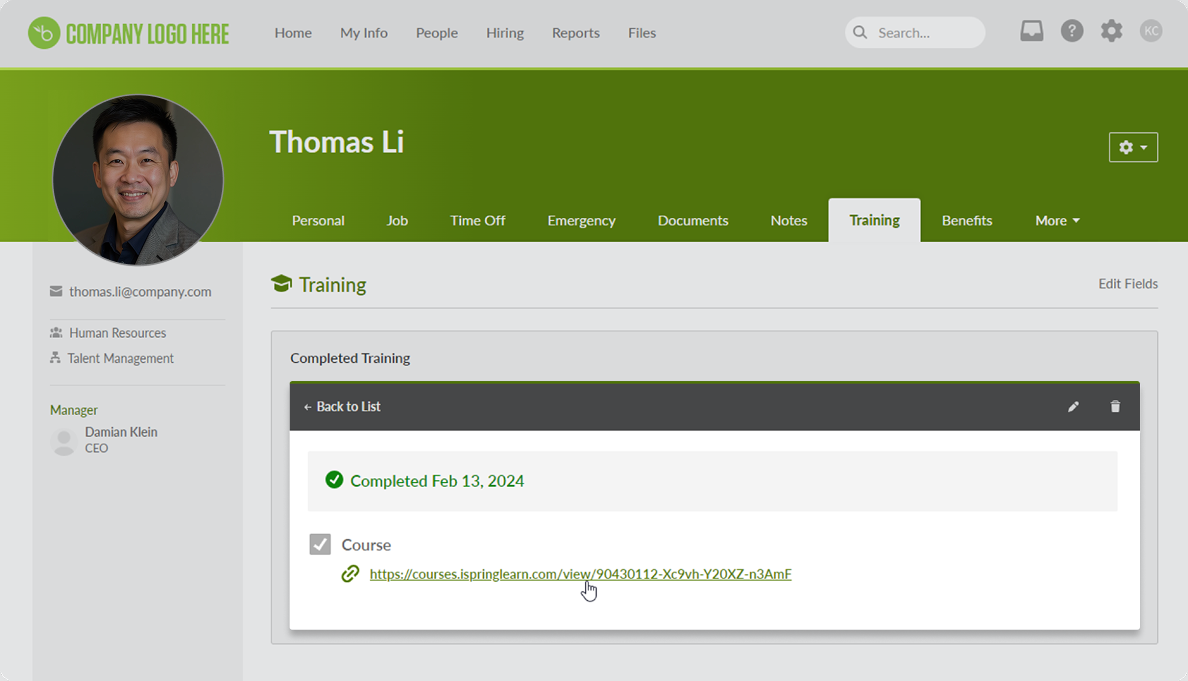
2. Customer relationship management (CRM)
Learning management systems offer various CRM integration options, from assigning courses directly within the CRM to linking training results with sales performance data.
For example, iSpring LMS’s Salesforce integration automatically syncs employee, partner, and customer data from Salesforce with their profiles in iSpring LMS.
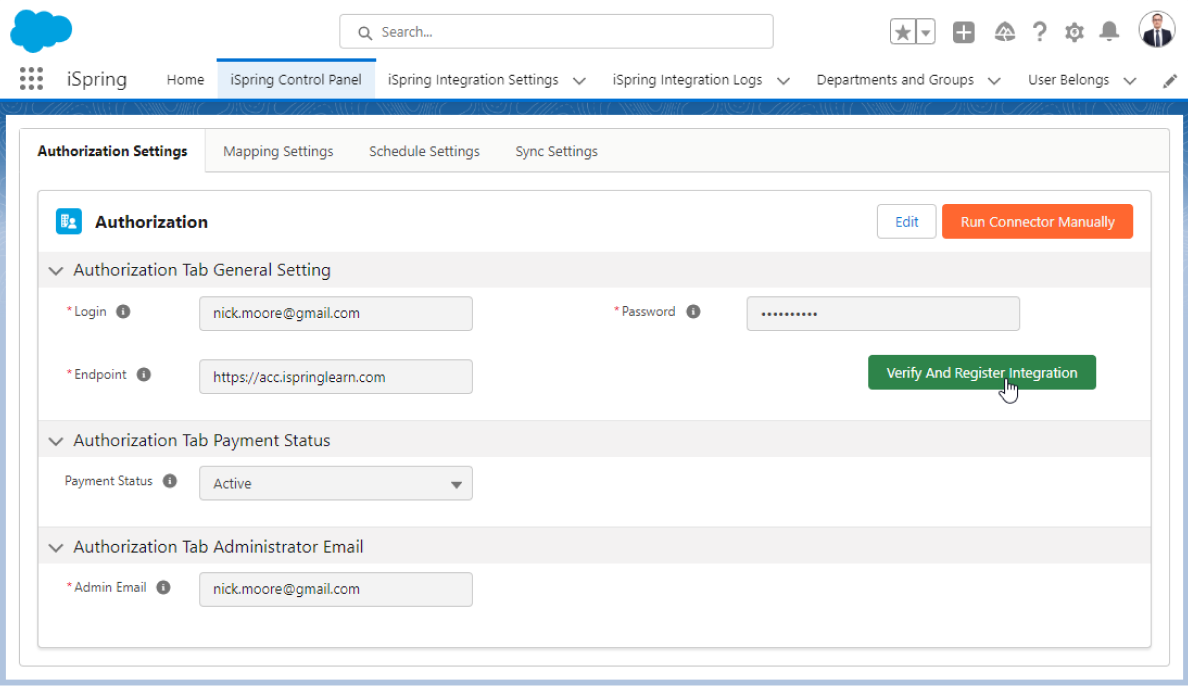
Also read: Salesforce Integration with iSpring LMS
3. Video conferencing
Integrating your learning management system with video conferencing software is especially useful when it comes to delivering blended learning.
For example, iSpring LMS integrates with Zoom, Microsoft Teams, and Courseboost collaboration tools. With this, you can conduct virtual meetings and online training sessions with your employees directly through the LMS platform.
Learners can access VILT (Virtual Instructor-Led Training) sessions directly from the LMS, while you can monitor their participation in live meetings through comprehensive LMS reports.
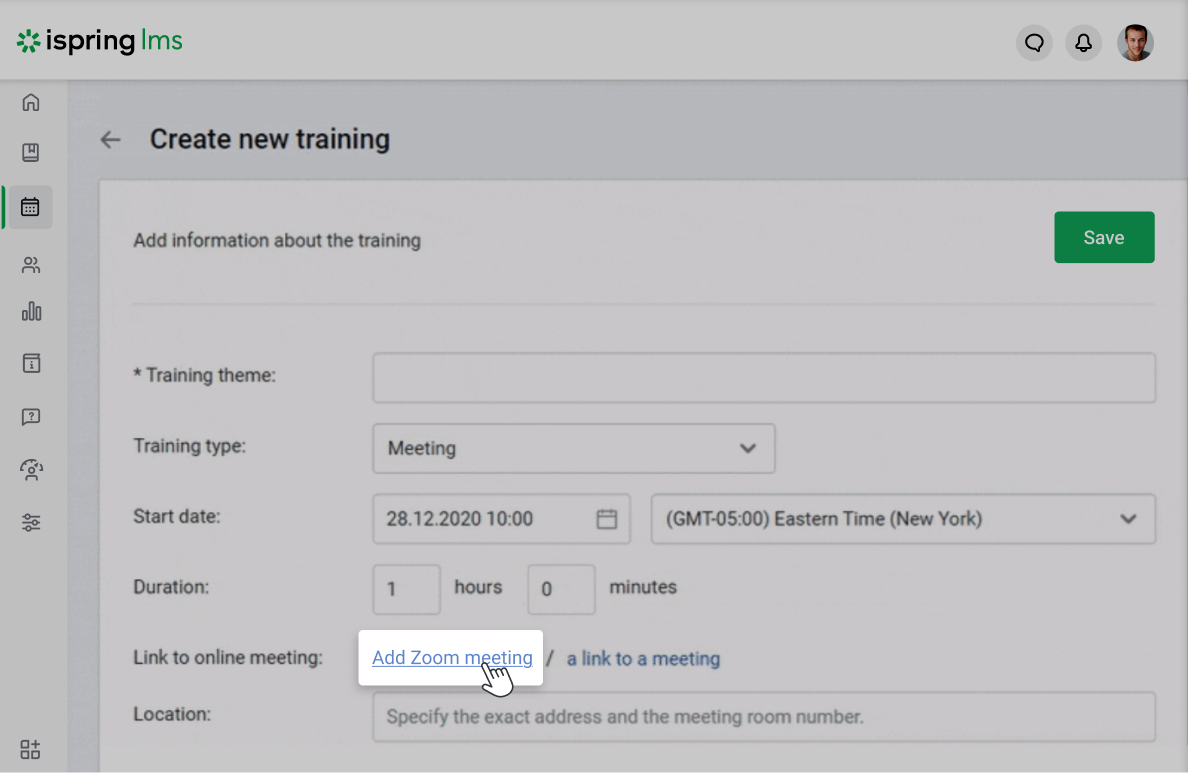
4. Calendars
Calendar integrations in iSpring LMS help learners and administrators easily stay on top of training schedules, creating a smoother learning experience. Webinars and sessions automatically sync to each learner’s Google Calendar or Outlook, so there’s no need for constant reminders. Everything appears in their familiar calendar app, ensuring they never miss a session.
For live sessions, such as Zoom or Microsoft Teams webinars, learners can join directly from their calendar event with a single click.
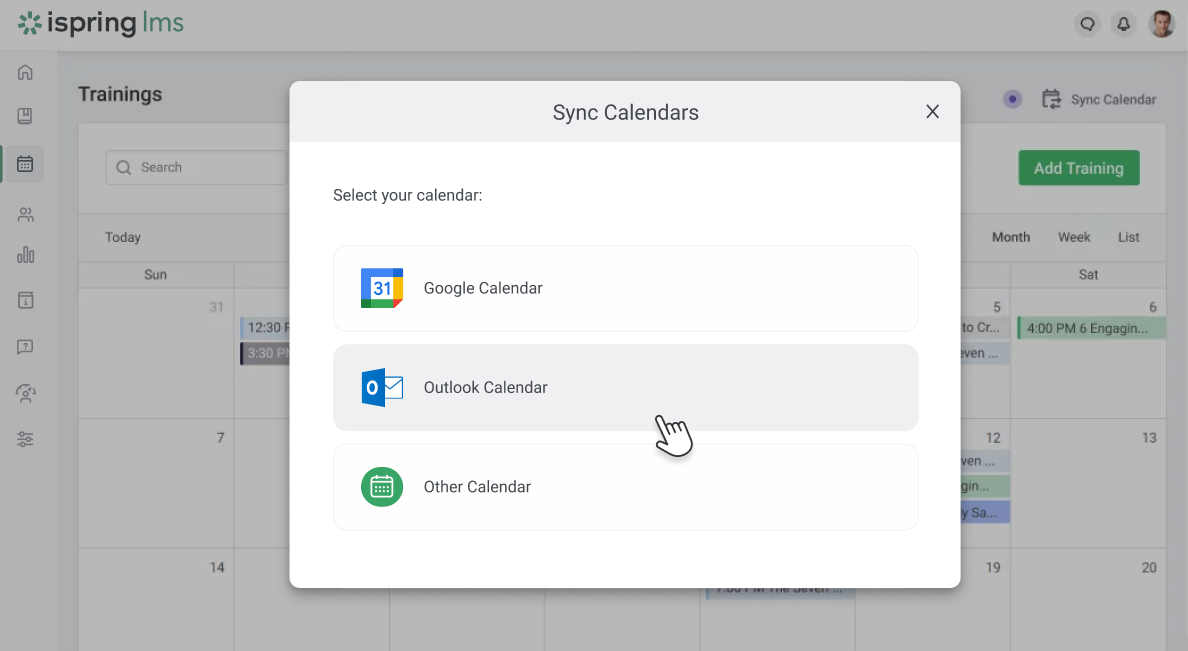
5. Single sign-on (SSO)
Log-in credentials are fodder for hackers. That means every time an employee logs in to one of these apps, there’s a security risk. LMS integration with single sign-on does a lot to reduce this risk.
Employees don’t have to constantly enter their login details. If they’re signed in to your corporate website or email server, iSpring LMS authenticates them automatically.
6. eLearning libraries
In addition to creating courses from scratch, organizations can provide their teams with access to ready-made training content that covers a wide range of topics, from soft skills to technical expertise.
iSpring LMS integrates with leading eLearning providers, ensuring that access to training content, completion tracking, and reporting happen within a single learning platform. Currently, you can integrate this LMS with four eLearning libraries:
- Go1: one of the largest eLearning content aggregators, offering courses from over 250 providers in 40+ languages.
- LinkedIn Learning: a skill-development platform offering 24,000+ expert-led courses, built-in career-pathing, and AI-driven recommendations powered by LinkedIn’s professional data.
- GoodHabitz: a provider of online courses focused on leadership, productivity, creativity, digital skills, and strategic thinking.
- Udemy: a global online learning marketplace with 250,000+ courses.
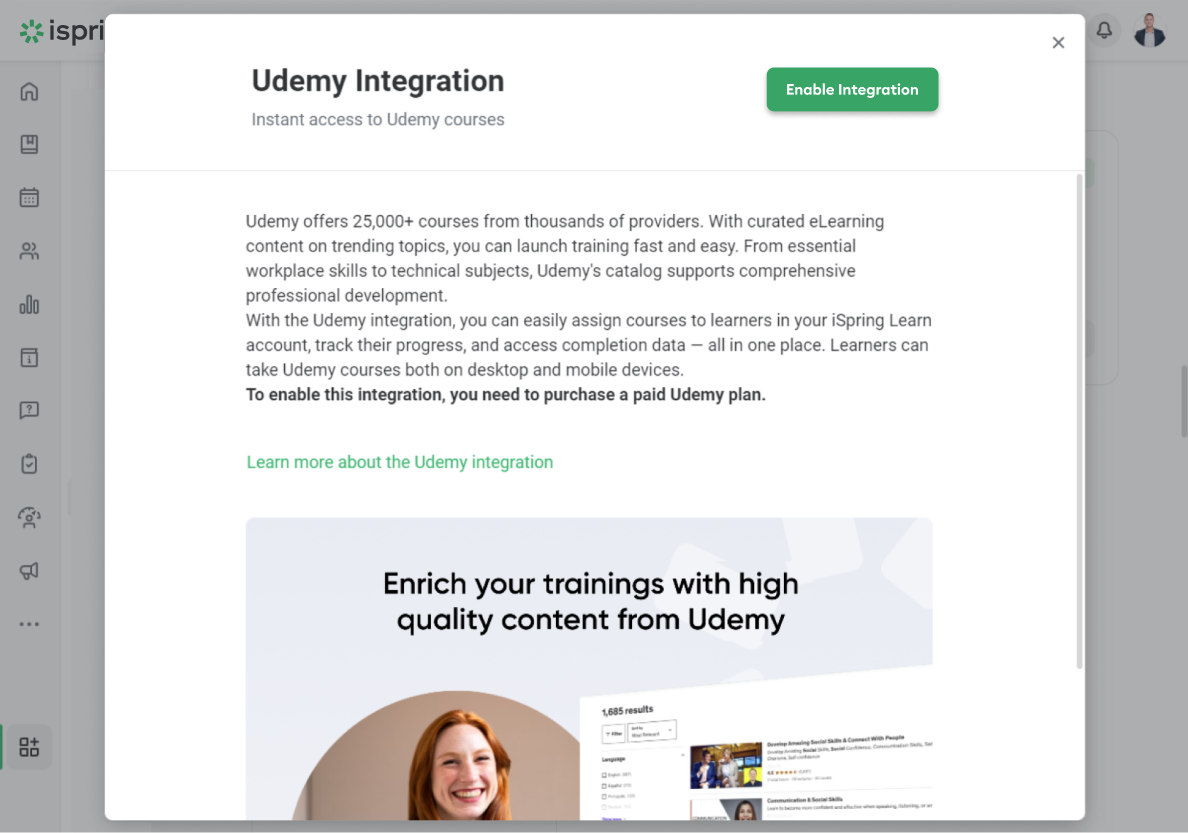
7. eCommerce
An LMS eCommerce integration with Shopify is a must if your organization plans to monetize training courses on its LMS.
With the iSpring LMS Shopify integration, when your courses are purchased from the Shopify store, iSpring LMS automatically enrolls the users in training programs.

How to Integrate an LMS: A Step-by-Step Checklist
LMS integration is an organizational shift that requires a structured approach to reduce risks, avoid extra costs, accelerate implementation, and ensure that a connected tech stack delivers lasting business outcomes.
Download a free collection of resources for LMS implementation.
So, let’s review the steps you need to go through when integrating an LMS with your tech stack.
1. Assess and prioritize your integration needs
Start by reviewing your learning strategy and existing training workflows to identify and rank the integrations you need most.
Your learning strategy defines what success looks like, whether that’s faster onboarding, stronger compliance, or better sales performance. Your overall learning priorities will determine which integrations you need to support them.
When reviewing existing training workflows:
- Talk to stakeholders from HR, IT, compliance, and training. Ask what systems they use daily for training and where bottlenecks occur.
- Review data flow with your IT team. When you audit the learning data flow with the team, track key employee events like hires, role changes, and course completions. Identify where data is being duplicated or lost.
- Identify reporting goals. Clarify which reports you need, such as compliance tracking, skills mapping, or ROI, and identify where that data currently resides.
Prioritize a list of “must-have” versus “nice-to-have” integrations. Focus first on the 1-3 that solve your biggest pain points or deliver the most time savings. For example, an integration that automates 10 hours of weekly manual data entry is a top priority, while connecting a rarely used webinar tool can wait.
Finally, define the specific functions you expect from each integration and confirm with your IT team what’s technically feasible. Once aligned, move on to the next step.
2. Choose an LMS that matches your integration needs
Look for an LMS with built-in integrations for your tech stack. This way, you can set them up quickly without custom coding.
For future-proofing, choose an LMS with flexible connection options like a reliable API or support for Albato/Zapier. This gives your IT team the ability to integrate specialized or custom apps as your needs evolve.
To facilitate your selection process, download this free guide: How to Select a Learning Management System
3. Plan integration
Work closely with your IT team to design how data will move between systems and clarify who’s responsible for each step.
Before development begins, map the data flow and define the specific information to sync between platforms.
Then, create a shared integration plan outlining the required resources, data protection measures, and a realistic timeline so everyone knows what to expect and when the system will go live. You need to ensure that the LMS integration doesn’t violate data security regulations or place the organization’s information at risk.
4. Set up and test the integration
Before a full rollout, conduct thorough testing of the LMS integration. This critical step catches inconsistencies early and prevents data errors or workflow disruptions at launch.
- Start small. Pilot the integration with a limited user group to confirm that user provisioning, course enrollments, and reporting work as intended.
- Simulate real-world scenarios. Test typical situations, such as a new hire joining the company, an existing employee changing roles, or completion of a course, to ensure that data syncs correctly and on time.
- Check for errors. Monitor logs for failed syncs or mismatched data and verify that reports display accurate information.
- Gather feedback and adjust. Collect input from pilot users, fix configuration issues, and refine settings before full deployment.
5. Train users on the changed workflow
Develop targeted training initiatives that show each stakeholder how the integration affects their daily work. Focus on what’s new, not the entire LMS. Highlight the new automated steps and demonstrate how they simplify routine tasks.
6. Launch the LMS integrations and monitor
Once testing is complete and stakeholders give their approval, make the system accessible to all users, set up permissions, and activate the connected tools. If possible, roll out the integration gradually (starting with one team or department) to minimize disruption and allow time for fine-tuning.
After launch, continuously monitor whether the integration works as planned in the first setup. Track adoption, data accuracy, and workflow efficiency through LMS analytics or BI dashboards. Collect feedback from users and administrators to uncover issues early and identify needs for improvement. Maintain and update the integration regularly to ensure long-term stability and alignment with evolving business needs.
Final Thoughts
LMS integrations align your online training platform with your existing corporate tech stack to simplify business processes and centralize data. Beyond improving the learning experience, they give your organization easy access to essential information in one place. This helps deliver training that drives measurable business outcomes.
If you’re looking for a powerful LMS, book a free demo of iSpring LMS to see it in action and confirm it matches your needs and expectations.
FAQ
Here are some of the most common questions asked about LMS integration:
What are the challenges regarding LMS integration?
An integrated LMS can bring many benefits, but it also comes with challenges:
- Compatibility is a common issue because not all third-party tools are designed to work seamlessly with every LMS, requiring custom API development or middleware solutions.
- Data synchronization errors can also occur if systems don’t update in real time or if there are inconsistencies in how data is structured.
- Employee data security risks are another concern, as integrating multiple systems increases the need for strong data protection measures, such as encryption and access controls.
- Setup complexity: Some integrations require IT expertise, especially when dealing with APIs or custom configurations.
- System performance can be affected if too many integrations run simultaneously without proper optimization.
Careful planning, testing, and ongoing monitoring can help organizations overcome these challenges and ensure smooth LMS integration.
What is an API, and how is an API different from an LMS integration?
An API (Application Programming Interface) is a set of rules and tools that allows different software systems to communicate and exchange data. With an LMS, an API lets developers build custom connections between the LMS and other applications. However, this type of integration usually requires that your IT team sets it up and maintains it.
A native LMS integration, on the other hand, is a pre-built connection that already exists within the LMS or the partner tool. It’s ready to use, requires little to no technical setup, and can often be activated with just a few clicks.
Can I choose which data gets shared between my LMS and other systems?
Yes, most LMS platforms allow you to control which data is shared between your LMS and other systems. When setting up an integration, administrators can typically configure what information is exchanged, such as user profiles, course progress, completion records, or enrollment details.
